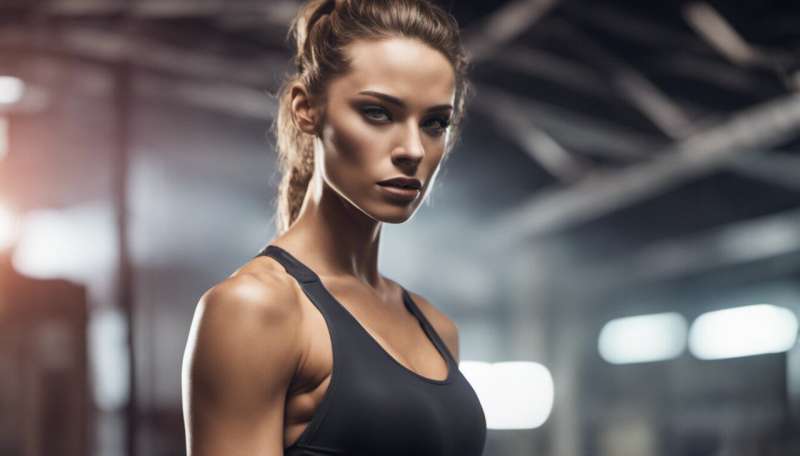This article has been reviewed according to Science X's editorial process and policies. Editors have highlighted the following attributes while ensuring the content's credibility:
fact-checked
trusted source
written by researcher(s)
proofread
Wearing a well-fitting sports bra can improve your performance. An expert advises how to find one

One of the lasting memories of the 2022 Uefa Women's Euro is England's Chloe Kelly celebrating her match-winning goal by taking her shirt off and running towards her teammates in sheer joy. It was seen as a significant and empowering moment for women's sport as the image of a woman in her sports bra was a representation of skill and power, not an objectification of her body.
Sports bras are being recognized across elite sport as an essential part of the female athlete's kit. In a survey of UK female athletes, 51% experienced breast pain and 29% said that poorly fitting bras affected their performance. Before the Tokyo Olympics and Paralympics, Team GB athletes and para-athletes were offered a bra prescription service in which they were fitted with a sports bra based on an individual assessment. Around 97% of those prescribed a bra reported benefits in comfort, fit and support, while 17% said it had significantly improved their performance.
But sports bras are just as important for every woman taking part in exercise.
Anatomically, the breast has limited internal supporting structures. Breast tissue is composed of glandular and adipose tissues. Within the adipose tissue is a network of nerves, blood vessels and a connective tissue known as Cooper's ligaments. Along with the skin, these are the only natural supporting structures of the breast. As such, when the body moves, the breast will move independently, which can be difficult to control.
Both structures can stretch during excessive movement. If overstretched, they cannot recover, which can lead to damage of the breast skin but is thought to cause breast pain.
Excessive breast movement has also been found to negatively affect physiological and performance measures. When comparing physical activity between low and high breast support conditions, there is evidence that performance is reduced in low support. This includes inefficient running technique and taking shorter strides.
There is also evidence that breathing frequency is altered, with low support levels reducing how often you breathe. The upper body has been reported to work harder during exercise when wearing low support, making you fatigue faster. And there is evidence that exercising in low breast support can increase your ground reaction forces, which is how heavily you land on the ground, increasing your risk of leg injury.
Not only can wearing the correct level of support improve performance, reduce breast pain and the risk of breast damage, it has also been shown to reduce embarrassment experienced by women during physical activity, as well as helping to improve body image and self-esteem.
What makes a good sports bra?
Sports bras can be classified into three types: compression, encapsulation and combination bras. A compression bra is usually made from one piece of strong elastic, and it works to compress breast tissue to the chest to limit breast movement. Encapsulation bras are designed to support and limit the movement of each breast individually, while combination bras have characteristics of both compression and encapsulation bras.
For a high-support sports bra, there are five characteristics to look for that have been linked to reduced breast movement. Encapsulation style, padded cups, nylon material and an adjustable underband are all desirable. High-support sports bras also tend to have a higher neckline—for every 1cm higher the neckline, breast bounce is reduced by 1%.
One secret to a good sports bra is fit. It has been reported that 70-100% of women are not wearing the correct bra size. It might be that you are a different size in different brands, so the best way to make sure you are wearing the correct bra size is to follow the best-fit criteria.
The traditional method of bra fitting, using a tape measure to determine band and cup size from underbust and overbust measurements, has been shown to overestimate band and underestimate cup sizes. The best-fit criteria look at five components of the bra and how they fit against your body. The underband should be level around the chest, not too tight, and should not slide around as you move.
Breasts should be enclosed within the cups, with no gaping or bulging. The center of the bra should sit flat against the breast bone and not gape. Straps shouldn't be too tight and dig into your skin, nor should they have more than a 5cm stretch. The main support for the breasts should come from the underband, not the straps. Finally, if the bra has an underwire, this should follow the natural crease of the breast and not rest on any breast tissue.
Sadly, according to a survey by Sport England, 43% of girls will stop participating in sport during their teenage years. With breast size and excessive breast movement identified as barriers to exercise, a well-fitting sports bra can help to break down these barriers, empowering girls and women to continue to participate in sports and exercise.
This article is republished from The Conversation under a Creative Commons license. Read the original article.![]()





















